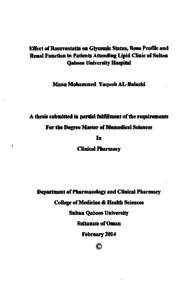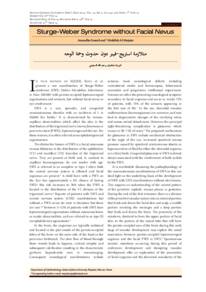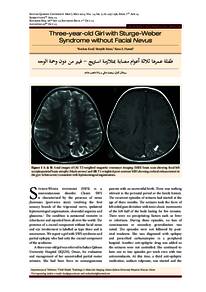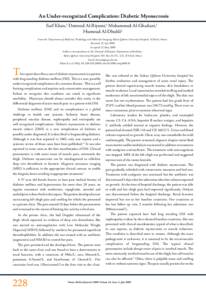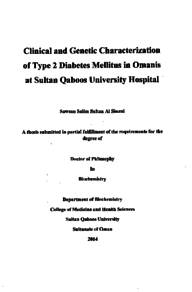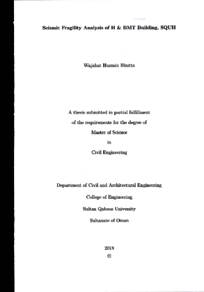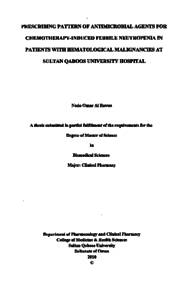Document
Effect of rosuvastatin therapy on glycemic status, bone profile and renal function in patient attending lipid clinic of Sultan Qaboos University Hospital
Publisher
Sultan Qaboos University
Gregorian
2014
Language
English
English abstract
Background: Statins are widely prescribed for primary and secondary prevention of cardiovascular events. Rosuvastatin is used extensively nowadays, however its long-term adverse effects on glycemic status, bone and renal function have not fully evaluated as yet. Aim: To determine the efficacy and safety associated with use of rosuvastatin in dyslipidemic patients attending lipid clinic at SQUH over a period of 3 years. Method and Results: The retrospective study analyses electronic medical records of 144 patients from Hospital Information System (Trakcare) on rosuvastatin for treatment of dyslipidemia during the time period from June 1st, 2009 till May 31st, 2012. Changes of laboratory reading were compared to baseline. Rosuvastatin significantly reduced LDL-C, apo B, total cholesterol and TG compared to baseline p<0.05. However, HDL-C was significantly increased at 6 and 12 months compared to baseline while apo A-I was not increased significantly. Fifty one percent of patient achieved LDL-C target of NCEP ATP III. HbAlc was significantly increased in non diabetic patients at 6 and 30 months of rosuvastatin therapy compared to baseline while FBG was increased significantly at 18 and 24 months of therapy in non diabetic patients. Rosuvastatin showed no significant change on ALP, adjusted calcium and serum phosphate levels in medicine that affect bone non-user. Serum urea level was reduced -22% from baseline after 30 months of rosuvastatin therapy p<0.05. Percentage change in serum creatinine level was significantly increased at 24 month (4%) and at 36 months (8%) and significant decline of eGFR were observed at 24 and 36 month (-6.5 and -11 %, respectively). eGFR of non-diabetic patients declined significantly at 24, 30 and 36 months comparing to baseline. Conclusion: Rosuvastatin was effective in reducing LDL-C, apo B, total cholesterol, and TG, however, the effect was not time-dependent, as the reductions after 12, 18, 24, 30 and 36 month were not more than the reduction occurred after 6 months. Moreover, it was not able to increase the HDL-C and apo A-I after one year of therapy. Half of patient achieved LDL C target. Rosuvastatin increased HbAlc in non diabetes and this increment might be more evident in cases of impaired glucose tolerance. This is in line with the recommendation by the FDA warning of possible association of rosuvastatin therapy with increase risk in new - onset of diabetes. Rosuvastatin effect on bone profile, rosuvastatin did not show any positive or negative impact on bone health. Rosuvastatin treated patients showed a significant decline in eGFR after 2 years and 3 years of therapy. The study had some limitations: sample size was small, a retrospective study and patient data incomplete.
Member of
Resource URL
Arabic abstract
المقدمة: الستاتين توصف على نطاق واسع للوقاية الأولية والثانوية من حدوث أمراض القلب والأوعية الدموية. روزیوفاستاتين هو واحد من الستاتين الأكثر فعالية المستخدمة على نطاق واسع في الوقت الحاضر. غير أنها قد يكون لها آثارا ضارة طويلة الأجل في حالة نسبة السكر في الدم، والعظام والمودة الكلوي التي لم يتم توضيحها حتى الآن. الهدف : لتقييم فعالية وأمان من استخدام عقار روزیوفاستاتين للمرضى المراجعين بعيادة الدهون في مستشفى جامعة السلطان قابوس على مدى 3 سنوات. الأساليب والنتائج: تم دراسة السجلات الطبية الإلكترونية ل 144 مريض الذين استخدموا روزيوفاستاتين في علاج فرط شحميات الدم خلال الفترة الزمنية من 1 يونيو 2009 حتى 31 مايو 2012. وتمت مقارنة التغيرات من خلال القراءات المخبرية ومقارنتة باول قراءة . ساهم روزيوفاستاتين في خفض بروتين شحمي منخفض الكثافة و صميم البروتين الشحمي ب و ثلاثي الغليسريد و مجموع نسبة الكولسترول بشكل ملحوظ بمقارنة عند بدء العلاج بينما بروتين شحمي مرتفع الكثافة لم يرتفع اكثر عن المعدل 6 و 12 أشهر و صميم البروتين الشحمي الف-I لم يظهر أي ارتفاع ملحوظ. واحد وخمسون بالمئة من المرضى حققوا المستوى المطلوب بروتين شحمي منخفض الكثافة حسب توصيات البرنامج القومي التثقيفي عن الكولسترول الإصدار الثالث من علاج البالغين. حالة السكر في الدم من خلال اختبار الهيموجلوبين السكري الذي زاد بشكل ملحوظ في غیرمرضى السكري في 6 و30 شهرا بالمقارنة من بدء إستخدام عقار روزیوفاستاتين وقياس السكر الصيامي حيث زاد بشكل ملحوظ في 18 و 24 شهرا في غير مرضى السكري. لم يظهر تغيرات في أي من الفوسفات القلوية ومستوى الكاليسوم والفوسفات بالعظام الذين لم يستخدموا أدوية تؤثر على وظائف العظام. وظائف الكلى تم معاينة مستوى اليوريا في الدم حيث نقص بمعدل 22% بعد 30 شهرا من استخدام العقار. زادت نسبة التغير في مستوى الكرياتينين بشكل ملحوظ في 24 شهرا (4%) وفي 36 شهرا (8%) ولوحظ ايضا انخفاض بمعدل الترشيح الكبيبي التقديري في 24 و 36 شهرا (-6 . 5 و -11٪ على التوالي). وقد لوحظ إنخفاض بمعدل الترشيح الكبيبي التقديري في مرضى الغير مصابين بداء السكري. الإستنتاج: روزیوفاستاتين كان فعالا في خفض بروتين شحمي منخفض الكثافة و صميم البروتين الشحمي ب و ثلاثي الغليسريد مجموع نسبة الكولسترول ومع ذلك كان التأثير لا يعتمد على مدة العلاج و التخفيض بعد 12 و 18 و 24 و 30 و 36 شهرا وليس أكثر من الحد ما بعد 6 أشهر. وعلاوة على ذلك فإنة لم يكن قادرا على بروتين شحمي مرتفع الكثافة و صميم البروتين الشحمي الف . نصف المرضى حققوا المستوى المطلوب من البروتين شحمي منخفض الكثافة. ازداد مستوي اختبار الهيموجلوبين السكري في غير مرضى السكري وهذه الزيادة قد تكون أكثر وضوحا في حالات ضعف تحمل الجلوكوز السكري متماشيا تحذير إدارة الغذاء والدواء. فيما يتعلق بالتأثير على الفحوصات الشخصية العظام روسوفلستاتين لم تظهر أي تأثير إيجابي أو سلبي على صحة العظام. وأظهر العقار انحفاض في وظائف الكلى بعد سنتين و 3 سنوات من العلاج على الرغم من قلة عدد العينات في هذه الدراسة.
Category
Theses and Dissertations

